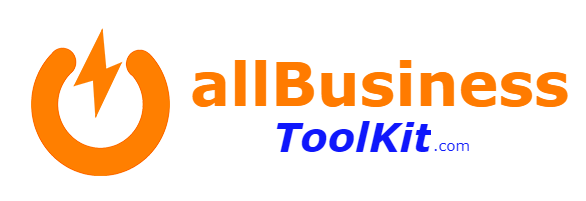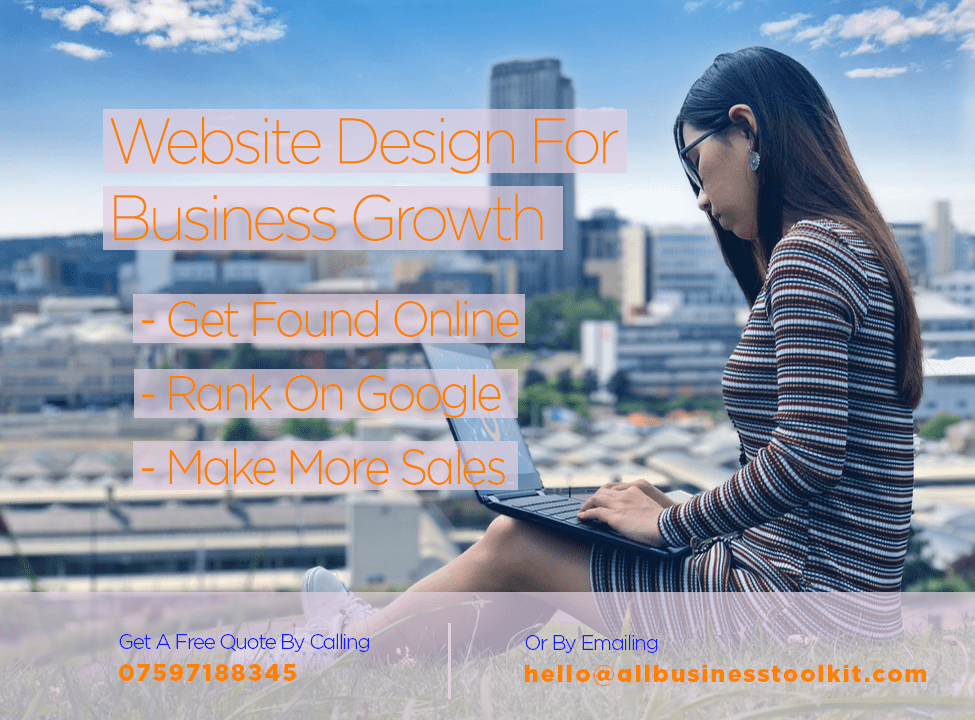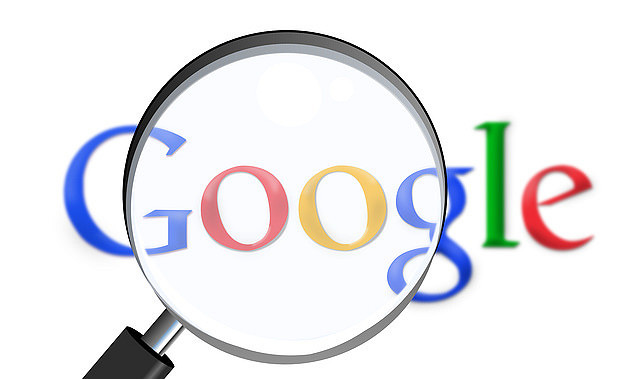When you realise that every interaction you make online is influenced by some form of content, you begin to realise that why content is the forefront of every marketers strategy.
What is content marketing? Content marketing is the process of creating and distributing copy, images and videos that is valuable to your target customers needs.
In this article, we will discuss content marketing in more detail…
1. What Is Content Marketing?
Content marketing is a term that is more generally used in digital marketing. People online are always surfing for information, maybe they have a problem and want to find answers, or looking to evaluate their next purchase. Content marketing aims to provide information to people online that are searching for answers. They come in the form of copy, imagery and infographs and videos. Using tools like websites, blogs and social media.
2. Why Is Content Marketing Important?
I was reading statistics just the other day which I found extremely alarming. In the B2B industry it is estimated that 92% of purchases start with search and 81% of consumers shop online. Moreover, 29% of marketers budget is spend on developing content, by which only 37% of marketers think they have the ideal content strategy whilst the others don’t know.
If a search is started online it most likely comes from a search engine, whereby they will be introduced to some form of content on your webpage. If you do not think your content satisfies the audiences need then you are not measuring it and something must be done. Leading traffic to your website is already a very time consuming and an expensive task. So, you need to take advantage of every visitor that enters your site from the get go.
Influencing every visitor to be excited to read your posts in the future. Only by doing this will your visitors subscribe to your channel or website whereby relationships can be built. Only by having good content can you sell your products.
3. Types Of Content
Before planning any marketing strategy it is fundamental to understand the many types of content. In addition, every potential customer will go through both a mental and physical journey before trusting your brand enough to purchase. There are many types of content you can create that will fulfill a part of the customer journey at the point they require it.
Blog Posts/Articles
A blog is a conversation or informational website that consists of discrete, frequently informal diary-style text entries and is published on the World Wide Web. Typically, posts are shown in reverse chronological order, with the most recent post appearing first at the top of the web page.
White Papers, eBooks, and Reports
An eBook is frequently used as a comprehensive guide to a topic for a general audience. A whitepaper is a type of academic report on a specific issue that delivers fresh research or information to a smaller group of professionals.
Podcasts
A podcast, like Talk Radio, is an audio programme that you can subscribe to on your smartphone and listen to anytime you want.
Email /Newsletters
The act of sending a commercial message to a group of people is known as email marketing. It entails sending advertisements, soliciting business, or soliciting purchases or donations by email.
Videos
Video marketing is the use of videos to promote and market your product or service, boost engagement on your digital and social media platforms, and educate your customers.
Infographics
Infographics are graphic visual representations of data, knowledge, or information that are meant to deliver information quickly and clearly. They can increase cognition by enhancing the human visual system’s ability to see patterns and trends with visuals.
Service Content
Service content is used for more technical businesses only. These types of business provide application based support in the form copy and images. This inofmration would usually be distributed in online portals or instruction manual.
Credibility Content
Credible content is produced from professionals in an industry. This person will have been working in an industry and come across many challenges related to the content. Even though Google doesn’t agree with guest posting, sometimes you can produce some really credible content if the guest has lots of prior experience. This can come in form of case studies and leaflets and a testimonials.
Branding Content
Marketing content can include branding and create an association to click baiting. Branding of content that helps position you as an expert and puts your business in front of prospects earlier in the buying cycle. This can only be achieved by association, this is ensuring an emotion is rightly associated with the voice, tone and imagery projected into content. Every piece of content must have a marketing flair to it, for a more powerful impact for the reader, however if you do try to click bait, the you need to live upto that promise in the linking page.
4. What Makes A Good Piece Of content
Quality content refers to how well a piece of information is structured. However, you may have a really quality piece of content but that doesn’t provide insight or value for what the reader is looking for. Ideally the content your produce needs to be of quality so it is easy for the reader to interpret but also useful. Useful content provides a solution to a persons problem, this can be based on your own personal experience. To produce this type of content you must examine the market and look at the types of questions people have. Useful content will provide the answers to those questions.
5. Six Tactics Of Content Marketing
I have conduced a lot of content marketing for websites and social media. I have come to notice that even though the volume of interaction can vary depending on the business and industry; but engagement and bounce rate is always consistent when I apply these six methods.
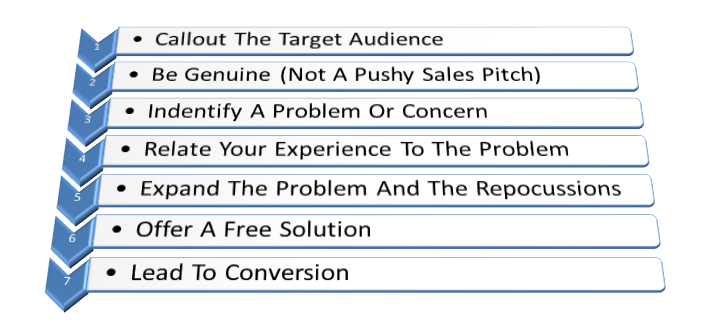
- Call out the audience – When you are writing any content copy you need to know exactly who you are writing for, but not only that you need to call out the person you are writing for in your copy to reassure that person.
- Be genuine – There are far to many people out there trying to force their products on you, which it is quite common to tune out. People are more interested in genuine people than sales people.
- Identify a problem – If you are able to identify a problem you target reader has then, tell them what it is. They will instantly want to read more, and this is the best way people will relate to you.
- Reflect off personal experiences – If your experience is the same as your readers experience they will find you the most credible and will be want to read if your solution will work for them.
- Expend the problem and its repercussions – By expanding the problem you are teaching things the the reader may of overlooked. If you can identify something they will re-evaluate there own reality, as it suggests you are a professional and more credible. Also, Google doesn’t rate webpages with less than a 1000 words credible so it is a opportunity to make your content more meaty.
- Offer a free solution – If your solution works for the reader then they will no doubt be emotionally indepted to you.
- Lead to paid product or subscription – If you have done all the above then the chances this person will move down the sales funnel. They will most likely be more than willing to give you’re their personal information for you to contact later on.
5. Content Marketing Process
The process I am about to show you also stimulates creativity and provides quality to your readers, even during times of writer’s block.
Content Marketing Process Model

So, let’s get it right the first time, and make the most of every visitor that lands on our page, leading them to sign up for your channel.
6. Aims, Objectives & Goals
Before we jump straight into creating content (copy, imagery or video) we first need to understand the purpose for doing this. I cannot stress the importance of doing this. Actually, I find it surprising how many people do not do this because they think it is wasting time.
70% of your time at work is wasted on tasks that add no value to the consumer (according to fastcompany.com). There is a lot of speculation why this is, but the general idea of lean management suggest it is not having a clear idea which tasks result in added value.
From my own experience I find a massive increase in my productiviety when I first lay out basic aims, objectives and goals. Mainly, because it gives us an ability to focus and exclude tasks that do not align to these. This ensures what you are doing is meaningful.
Example:
- Aim: To increase leads to your website by 10 %
- Objective: Create a blog post that is 2500 words being keyword optimised
- Goal: Rank first page on Google search for the desired keyword
The aims objectives and goals suggest what is important to our business, and what we want to get from producing this piece of content. The more specific you can make this then the more effective it will be.
7. Target Audience
To be found on any search engine we need to have engaging content. If the content is not appealing to the reader then it will not rank. This means when we produce anything we need to understand who we are producing if for.
During this activity we highlight what is important to our readers.
- What do our readers want to read about?
- What is it that they need to know about?
You may have to conduct some market research online by reading through comments on social media and highlight questions people have.
8. Ideal Positioning
An ideal position is looking for a win win from what is important to your business and what is important to the target audience.
9 Evaluation
The biggest challenge for SEO is first getting people to click on your article, and then keep them hooked once they are on your webpage.
We can measure these by evaluating:
- Click-through-rate (to learn more, click here..)
- Bounce-rate (to learn more, click here..)
- Conversion-rate (to learn more, click here..)
Points 1 and 2 are good measures why a page may have low conversion rate, which concludes that your priorities should be to increase click-through rate and decrease bounce rate. Once the user signs up to the newsletter, the user has transitioned into the customer and you can start to build a relationship with them (this will include selling them your affiliated products or advertising). A Methodology is the systematic, theoretical analysis of the methods applied to the activity. The activity is this case is how to lead a new visitor to sign up for your newsletter.
10. How To Increase Your Click Through Rate
The page title – craft a headline that hooks the reader
Before writing the title, it is important to understand the purpose of the titles. Ask yourself this question? Why do I have a title? Answer the answer is, to get the visitors hooked, and lead them to the introduction section.
So, to get the reader hooked on a title is known as Sounds bites and click bait, which it is important to keep in mind break the usual rules of English grammar. In addition, with sound bites and click bait there is not logical construct it is kind of hit and miss.
The basic construct of a title has to include 1 keyword, 70 characters, Use numbers and special charters, capitalise the first letters on each word, bold important text and most importantly use active verbs as these are the framework for title construction, to keep the reader hooked (follow the link to have a detailed breakdown of constructing titles that convert).
The message needs to be direct to the pain point and the desired action, and by giving away something for free, which adds value to a person’s life, will break down their barrier of scepticism.
A typical example would look like;
How to “insert the desired outcome” without “insert pain point”!
11. How to reduce the bounce rate
The first priority is to address the target visitor in the title of the page, to remind them why they clicked on the page.
There are several ways to do this;
- Identify your audience with a question (learn how to identify your target audience online)
- Input Power Words (example: words that ignite a specific emotion)
- Input a problem and engrain it into the title
- Promise the reader some knowledge that will improve their life
Moreover, it is being detailed and clearly outlining exactly what the reader will find. Avoiding any generic ambiguities as this causes readers to be left with assumptions and uncertainty that will subconsciously discourage potential buyers as they don’t have a clear grasp at first glance what exactly they will spend their time to look at.
The second priority is to offer some incentive for the reader to keep reading. This could be done in the title or the introduction and will remove any ambiguity and act as a hook to keep the visitor interested and continue reading. As customers are a sceptic, this stage is crucial to make an impression. The impression will not be positive by throwing products at people, rather giving them something for free, as an incentive to keep reading. This is done again by leading with value.
Educate
Education is the main way to lead with value as it includes offering something to their audience about why they experience the problem they do. Educate is the means to provide help in the message to the target audience.
Have A Compelling Introduction
Provide the reader with a brief outline the blog will cover, with a clear structure outlining the key points of discussion. Make the most of bulletins to get your article structured as clearly to the reader as possible. My approach would take these bulleting’s as subheaders in the main section. As you can see with this post I used a video introduction to some text.
Main Body
The aim of the main body is to provide the readers with the new information what your readers have not heard before and are eager to hear. The body section needs to be as relevant to the header as possible, not going off topic, but still bringing in all the new discussion point.
The best way to break down the content in the main body by subheadings, which should be numbered, making it easier for the reader to follow with constant reiteration of nice images. Studies show that today’s consumers have an attention span of 30 seconds, so images or flashy media will really help keep hooking their attention. These can be found on various sites such as Flickr, and you can get personal imaged produced on fivr.com for as little as five pounds.
Wire Frame
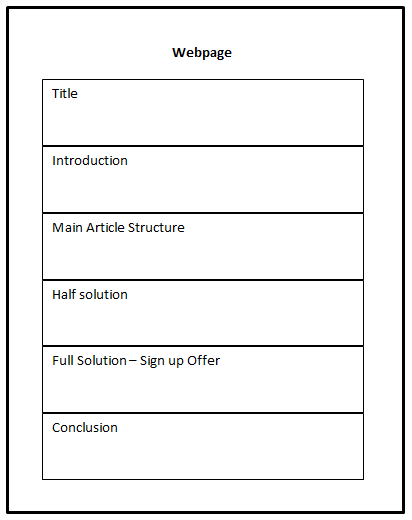
12. How To Increase Conversion Rate
Provide the Half-Solution
Conduct research to provide a clear answer to the reader’s problem The better you do this will gain the reader trust and if you do this well enough will gain The reader becomes dependant on you. In addition, I like to call this providing a half solution, thereby providing the full solution would lead the visitors to leave as soon as you have delivered it. This could be seen as a cliffhanger, whereby visitors are led to leave their email for the full solution is provided.
Half Solution
The half solution will be developed into the main body, however, I have outlined it separately to reiterate the importance of providing content that’s aim is to solve people’s problems.
Full Solution
This is a paragraph will a full description of wider contexts that affect the problem your readers are having. It will provide information that leads the user to sign up to the newsletter, or email system, which is located below the paragraph, the aim to initiate a Call to action (blog post how to initiate a call to actions).
The Method
- Advertising – if your blog is getting many visits to certain profile then it can be advised to have organisations pay for their advert to be displayed on your website.
- Collect emails – This includes leading visitors to leave their details whereby you can speak to these people again in the future and build a personal connection over time.
- Affiliated products – You can tailor your full solution towards the affiliated products you sell and make a profit.
Conclusion
Thank you for reading this article and I hope it has helped you and gave you an insight towards planning your blog or article strategy. The article outlines question, whereby the writers will go out and seek, to be creative and efficient even with writer’s block. And I hope I have provided enough information to get you started.
As discussed each blog has a call to action, and the article only provides the half solution. The full solution will include the full funnel from gaining leads and how to deliver traffic to your content once you have written it. You can get access to this information by adding your email to the subscription box below. In addition, I will keep you updated on latest blog posts, around this topic and don’t worry I do not spam my visitors because that goes again our vision is delivering the best experience to our customer. Our intent is bringing readers back to the website more frequently to view our new content, so please subscribe below.
